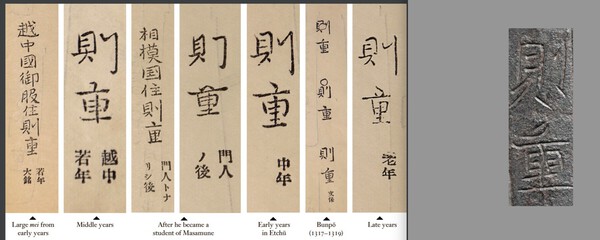-
Posts
1,063 -
Joined
-
Last visited
-
Days Won
5
Content Type
Profiles
Forums
Events
Store
Downloads
Gallery
Everything posted by Lewis B
-
Very nice looking sword with a sayagaki by Tanobe who was President of the NBTHK for many years and considered a pre eminent nihonto expert and appraiser. Some value his appraisals over the NBTHK.
-
Should be reported. Different locations. Against Ebay rules
-
I became fascinated with samurai and nihonto watching The Water Margin and Monkey as a kid growing up in the UK. Saw a few swords in museums but owning a blade was out of reach financially, so I stuck with stamp collecting. About 10 years ago I got into artisanal kitchen JKnives and eventually started to look at nihonto again, joining the NMB in 2020. With the funds now available I can afford what I like. Koto blades. My first blade, a Yamato Shikkake, found me in Utrecht 2 months ago at the age of 60 and I couldn't be happier. Some well respected, elder NBTHK-EB members have examined it and saw no reason not to send it for Juyo Shinsa, which I plan to do next year. And so the bug has been acquired. My plan is to find a representative blade from each of the main Kamakura and Nanbokucho era Gokuden. I also have plans to visit Japan next year to acquire a deeper understanding of this fascinating area of collecting and connoisseurship. There is so much to learn and I'm sure this will become one of the major areas of interest for me as I contemplate retirement in 4 years time. I also joined the NBTHK so I've fallen hard.
-
Bravo
-
Yes, it's true. Andrew Ickeringill also posted the sad news on his FB page.
-
Sori is 0.7cm. Very small as it's massively shortened. Possibly half its original length.
-
How would this be rated? Late Kamakura and Juyo, attributed to Norishige. The nagasa is only 41cm so we can only wonder at how amazing this blade would have been originally. In my eye even if o-suriage there is an appeal to the sugata.
-
I think a lot can be learned from other successfully designed museums. Case in point was the wonderful museum at Bibracte in France. A totally immersive experience that guided the visitor through the history of the Gaulish village, a recreation of a forge, sanitation and many other aspects of life in the prehistoric settlement. The visitor downloads the museum app and by standing near the floor markers they get a 2-5 min account of what is being viewed using a GPS locator function. One of the best designed museums I have visited. Another is the Tintin museum near Brussels, which again used an app-centered guided tour of a museum designed from the ground up to enhance the visitor experience. I think apps are the way of the future especially for international visitors. So many more languages can be accommodated. Its how the app is integrated into the displays that is critical. It also cleans up the display cabinets and allows for a lot more detailed information about the exhibit to be conveyed.
-
The Samurai Museum in Berlin brought a Heian/Kamakura era sword that had a very similar sugata, to the Japan Art Expo. Wish I had taken a photo and got more details re maker etc. It was quite short but the overall shape and tiny kissaki was aesthetically very appealing. Maybe someone else who attended the show remembers it sitting on the shelf at the back of the booth.
-
I would take the Shintogo Kunimitsu tanto home though. What an absolute beauty. Full writeup here. http://www.nihonto-m...togo-kunimitsu-tanto
-
The figure was lifted from the Token Kantei Hikketsu. But I agree, Norishige was born in Etchu but it's unclear if he started swordmaking there. It seems clear he trained under Shintogo Kunimitsu in Kamakura then encountered and possibly learned from/with Yukimitsu, Go Yoshihiro and Masamune at various phases in his career. After his apprenticeship there, he moved back to Etchu and established a forge. Closer inspection of the Mei in Jussi's informative post, I would put the signature at the Gen'o period 1320 (Kunimitsu died 1319), when Norishige was around 30 years old and supposedly working with/under Go Yoshihiro, who also originated from Etchu and establishes a connection. These various influences could explain the changes in his signature and forging stylistically. The strokes of the kanji seem to be the closest to this era.
-
Accepting Brians challenge. My first choice would be #4.... no contest, but then I'm a sucker for Kamakura/early Nanbokucho era Koto blades. Last pickup #1
-
This is a very timely post. What I have come to understand is that my appreciation for a blade is dictated by how I react to it. The initial aesthetic impact is primarily down to the sugata and everything leads on from that. I have seen Masamune swords I wouldn't glance twice at and blades from lesser makers that have me hypnotised. It starts with the shape, then proportions, then the hamon and the finer forging detail in the jihada. My brain is going through a checklist subconsciously. These are 3 blades I have spent some time studying. I have my favourite even though at first glance all 3 look quite similar.
-
I came across this maker a couple of weeks ago. They are producing a series of honyaki kitchen and chef knives made using Tamahagane steel, that look amazing. You have a very fine piece there.
-
I will be visiting Japan next May and I have your museum on my list of must sees. Do you know if you will have a special exhibition in May 2025? If you can show us some of the English langauge info cards we would be happy to make suggestions. The more information the better IMHO. I didn't attend this exhibition in person but the information provided on the info cards for these Soshu blades was the right amount of detail. I liked that the swordsmith is given some context and his relative importance within the Den and that the features on the sword are described in detail, so that the observer can understand what they are seeing. All this adds to the experience, especially if the number of exhibits are limited.
-
If you haven't noticed I have a massive soft spot for Norishige. My goal is to eventually own one of his blades so in the meantime I'm doing as much study as possible. Part of that is studying the development of the smith through what was a long career. His style changed depending on the influences, location and stylistic preferences predominating at the time. Ko Hoki influences, a phase where his style was similar to his contemporary Masamune and early influences of Shintogo Kunimitsu, with whom he probably had a teacher/student relationship. His Mei changed too throughout the late Kamakura and Nanbokucho eras when Norishige was active. I'm trying to place the style of the Mei on the right. To my uneducated eye it looks most like the large Mei from early years on the far left with one caveat, the oblique chisel mark on the upper kanji, at the end of the righthand vertical element. The crescent mark at the top of the shige kanji, as well as the large horizontal lines seem to be the most indicative.
-

Shirasaya not closing all the way?
Lewis B replied to chinaski's topic in General Nihonto Related Discussion
I tried the whetting seam method to close up a shirasaya split but didn't work in my case, but glad to hear it worked for you. I would make sure the saya is completely dry before you store the blade in it. Any condensation could cause corrosion to start. -
I'm curious if anyone is a crossover collector. Nihonto and kitchen knives. I was into the latter for many more years than I have been into nihonto, primarily because the price of admission is logarithmically lower. I have 5 blades that were made by a certified third generation swordsmith in his late 70's. His swordsmithing name is Kanekuni (Kato Kanekuni) and his kitchen blades are under Yoshiaki Fujiwara. Real name is Kiyoshi Kato. This is the family lineage up to the father Kato Sanehira Kanekuni https://nihontoclub....isplay=image&id=2229
-
Dealer is saying if the bohi was Atobori it would not get Juyo. Personally I don't think this is correct if the blade is from a master smith and in otherwise excellent health. This particlar blade is papered to Norishige. All the evidence suggests it was a later carving possibly when it was shortened for aestheric or balance reasons. I cannot understand any instance whereby the bohi would end so cleanly at the hamachi if it was original. The literature also says horimono was rare for Norishige.
-
Looks like an edged blade strike although not hit with much force. I would expect a much more substantial impression if a sword had made contact even at minimal speed. I would say the impression in the saya suggests an accidental contact.
-
60+....just
-
As a matter of interest how do people organize payment and take possession? I'm guessing no one carries a wad of cash and bank transfers can take a couple of business days to clear. This was my experience when I purchased my Yamato Shikkake. I started the transfer on the Saturday but payment didn't clear until Wed. Luckily I was flying to the UK and was planning to be back in Utrecht the following Friday. I local dealer kindly took possession of the sword and koshirae and we met up when I returned so I could collect it. But this I imagine is not the norm. Paying with credit card may also be difficult, either the dealer isn't able to take that payment or the price exceeds the limit. Do the dealers at the show ship? I assume they would have to return home and ship from there which is less than ideal if international. It wasn't obvious they even bought suitable packaging for shipping. Would really like to have a plan in place before I attend my next show where I might find another blade I can't live without What is the experience of other attendees at these Shows?









